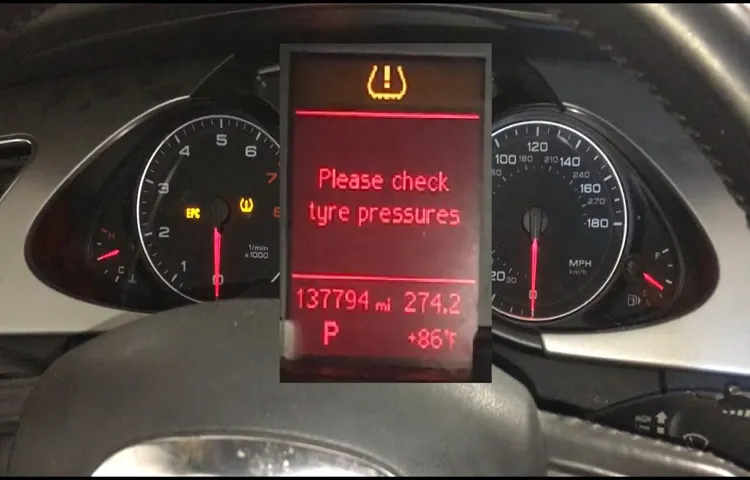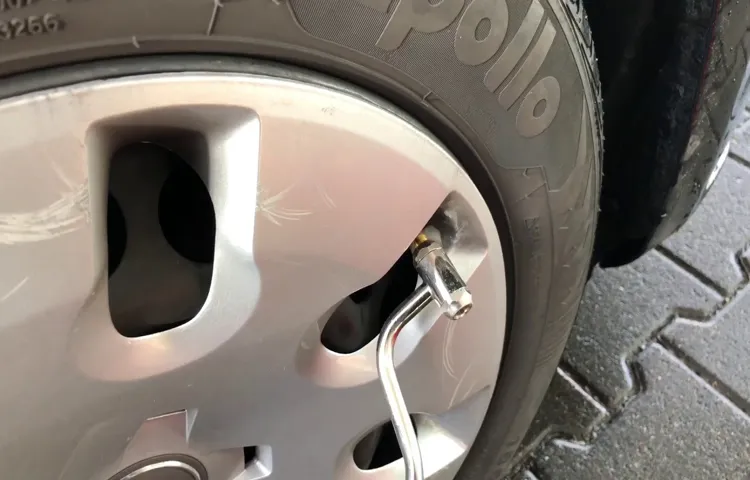Maintaining proper tire pressure is essential for your car’s overall health and performance. However, checking tire pressure can become a daunting task if you don’t know how to do it correctly. If you own an Audi, it’s crucial to know how to check tire pressure adequately, as it will save you time and money in the long run.
In this blog post, we will explore everything you need to know about checking Audi tire pressure, including why it’s necessary, how to read your tire pressure, and what to do if it’s too low or high. Keep reading to learn everything you need to know about Audi tire pressure!
Table of Contents
Why Checking Tire Pressure is Important
If you own an Audi, it is imperative that you regularly check your tire pressure. Tire pressure plays a vital role in the safety and performance of your car. Many factors can affect tire pressure such as temperature change, tire age, and slow leaks.
Maintaining proper tire pressure not only ensures your safety but also improves the fuel efficiency of your vehicle and extends the life span of your tires. To check your Audi’s tire pressure, first, determine the recommended pressure range from your owner’s manual or the sticker inside the driver’s door. Use a tire pressure gauge to measure the pressure of each tire and adjust accordingly.
Remember to check your tire pressure every month and before long-distance trips. Proactively taking care of your Audi’s tire pressure can prevent unexpected tire blowouts and accidents on the road.
Increasing Safety and Performance
Tire pressure is often overlooked by drivers, but it is crucial in ensuring their safety and improving their vehicle’s performance. Proper tire pressure affects your car’s handling, ride quality, fuel economy, and, most importantly, your safety. Low tire pressure can result in increased tire wear, decreased fuel efficiency, and poor vehicle handling, making your car more prone to accidents.
On the other hand, overinflated tires can result in reduced traction, decreased stability, and uneven tire wear. Regularly checking your tire pressure, ideally every month, can save you the trouble of experiencing the negative effects of low or high tire pressure. It can also prolong the life of your tires, reduce the risk of getting into an accident, and improve fuel efficiency, saving you money in the long run.
Additionally, tire pressure varies with temperature changes, so it’s crucial to check your tire pressure more frequently during extreme weather conditions. In conclusion, checking your tire pressure is an easy and crucial maintenance task that should not be neglected. It affects your car’s handling, ride quality, fuel economy, and safety.
Remember, a few minutes spent checking your tire pressure can make a huge difference in your driving experience. So, make it a habit to check your tires regularly, and you’ll enjoy safer and smoother rides on the road.

When to Check Audi Tire Pressure
Checking the tire pressure of your Audi is crucial in ensuring the overall safety and performance of your vehicle. It is recommended to check the tire pressure at least once a month and always before long-distance trips. You may also need to check the pressure more frequently during extreme temperature changes, such as during winter or summer months.
Maintaining the proper tire pressure can prevent uneven tire wear, provide better fuel efficiency and handling, and prolong the life of your tires. Checking your Audi’s tire pressure is a simple process that can be done with a tire pressure gauge, which can be found at any automotive store. Simply unscrew the valve cap on each tire, attach the pressure gauge, and compare the reading to your Audi’s recommended tire pressure, which can be found in the owner’s manual or on the driver’s side doorjamb.
Always adjust the pressure as needed and replace any damaged or worn-out tires promptly to ensure your Audi performs its best on the road.
Frequency of Checking
Checking the tire pressure of your Audi is a crucial part of maintaining your car’s performance and safety. So, when should you check the tire pressure of your Audi? It’s recommended to check the tire pressure at least once a month, or before embarking on a long drive. The ideal time to do so would be when the tires are cold, meaning they haven’t been in use for at least three hours or have been driven for less than a mile.
Checking your car’s tire pressure regularly can help you avoid blowouts, improve fuel efficiency, and extend the life of your tires. It’s also essential to make sure that the tires on both sides of the car have an equal amount of pressure to ensure a smooth and safe ride. Remember, neglecting to check your tire pressure can result in costly repairs and put the safety of you and other drivers at risk.
So make it a habit to check the tire pressure of your Audi on a regular basis, and enjoy a safer and more comfortable driving experience.
Preparation
If you own an Audi, checking your tire pressure regularly is essential for maintaining the performance and safety of your vehicle. The first step to checking your Audi’s tire pressure is to ensure that your tires are cold before you begin. Make sure your tires have been sitting for at least three hours or overnight before checking them.
You can then locate the recommended tire pressure for your specific Audi model by checking your owner’s manual. You may also find this information on the tire pressure sticker located on the inside of your door jamb or inside the glove compartment. Once you have found the recommended pressure, use a tire gauge to check the pressure of each tire individually and adjust as necessary.
Remember, uneven tire pressure can lead to handling issues, poor fuel efficiency, and even tire blowouts. So, make it a habit to check your Audi’s tire pressure at least once a month.
Gather Necessary Tools and Materials
Preparation is crucial when it comes to any DIY project, and gathering all necessary tools and materials is the first step to success. It’s important to make a list of everything you need before starting to avoid any last-minute trips to the hardware store. First, determine what tools are required for the specific project and ensure that you have all the essential ones, such as hammers, screwdrivers, and pliers.
Then, consider the materials needed, such as wood, nails, screws, or paint. For larger projects, it’s also important to have safety gear like gloves, safety glasses, and ear protection. Having everything on hand before beginning the project ensures that you can work smoothly and efficiently without any interruptions, saving time and effort in the long run.
So, prepare well and gather all the necessary tools and materials to give yourself the best chance of completing your DIY project successfully.
Steps to Check Audi Tire Pressure
Checking the tire pressure of your Audi is an essential maintenance task that ensures your car’s safety and performance while driving. The first step is to park your car on a level surface and turn off the engine. Next, remove the valve cap from the tire you want to check and attach the tire pressure gauge to the valve stem.
The gauge will display the current pressure, and you can compare it to the recommended pressure, which you can find in your Audi’s owner’s manual or on the inside of the driver’s door. If the pressure is too low, add air using a compressor or have a professional do it for you. If the pressure is too high, release air by pressing on the valve stem with a small tool.
Repeat this process for each tire, including the spare. It’s best to check your Audi’s tire pressure at least once a month or before any long trips. Properly inflated tires not only improve handling and fuel efficiency but also extend the life of your tires.
Step 1: Locate Your Audi’s Recommended Tire Pressure
When it comes to maintaining your Audi, checking tire pressure is an important task that should not be overlooked. The recommended tire pressure for your Audi can be found in a few different places, such as the owner’s manual or on the inside of the driver’s side door. It’s important to note that the recommended pressure may vary based on the size and type of tires your Audi has.
Once you have located the recommended tire pressure, it’s time to check the pressure of each tire. You can use a tire pressure gauge to check the pressure of each tire individually and make sure they match the recommended pressure. Regularly checking your tire pressure can improve gas mileage, increase the life of your tires, and even improve vehicle safety.
Don’t forget to keep your Audi rolling smoothly by following these simple steps!
Step 2: Remove Valve Cap
When it comes to maintaining your Audi’s performance, checking your tire pressure regularly is an essential part of your routine. One of the steps to take is removing the valve cap, which is the small cap that covers the valve stem of your tire. This cap protects the valve from dirt and debris, which can impact your tire pressure if not removed properly.
Using a valve cap removal tool or your fingers, you can easily remove the valve cap and keep it in a safe place, making sure not to lose it. With the cap removed, you can then attach your tire pressure gauge and check the pressure level. By following this step, you’ll be on your way to smoother and safer driving with your Audi.
Step 3: Use Tire Pressure Gauge to Check Pressure
Checking your Audi’s tire pressure regularly is an important part of keeping your car running smoothly and ensuring your safety on the road. To check your tire pressure, the first step is to find the recommended pressure for your specific Audi model, which you can usually find in your owner’s manual or on the information sticker located on the driver’s side door jamb. Once you know the correct pressure, the next step is to use a tire pressure gauge to check the pressure in each tire.
Simply remove the valve cap, press the gauge onto the valve stem, and read the pressure measurement. If the pressure is too low, add air until it reaches the recommended level. If the pressure is too high, release air until it is within the recommended range.
By following these simple steps, you can help maximize your Audi’s performance and stay safe on the road.
Step 4: Adjust Tire Pressure if Necessary
Adjusting Audi tire pressure is a crucial step in maintaining your vehicle’s performance and safety. To do this, you need to follow some simple steps to check your tire pressure correctly. First, use a tire pressure gauge to check the pressure level of each tire, individually.
The recommended pressure for your Audi can be found in the owner’s manual or on the vehicle’s tire information label. If the pressure is low, add air to the tire until it reaches the proper level. But, be careful not to overinflate the tire, as it would diminish its effectiveness and lifespan.
It’s best to repeat this process on each tire several times until you achieve the recommended pressure level. Properly inflated tires will prevent excess wear and tear, improve fuel efficiency, and provide better handling and safety on the road. Ultimately, investing some time in checking and adjusting your Audi tire pressure will not only extend the life of your tires but also keep you and your passengers safe while driving.
Step 5: Recap Valve and Double Check Pressure
Checking the tire pressure of your Audi is an essential part of maintaining your vehicle’s performance and ensuring safety on the road. Once you have successfully completed the steps of removing the valve cap, attaching the tire pressure gauge, adjusting the valve, and taking the reading, you are ready for step Now you must ensure that the valve is tightly closed, and that the pressure reading is what you expect it to be.
It’s important to double-check the tire pressure before driving to avoid any issues on the road. If there is any discrepancy in the pressure reading or if the valve is not tightened properly, take the time to make any necessary adjustments. By carefully following these steps, you can be confident in your Audi’s tire pressure and avoid any potential hazards while driving.
Conclusion
In summary, checking your Audi’s tire pressure can be a breeze if you follow these simple steps. Just like a relationship, it requires attention and care. Neglect it, and you’ll end up with a flat outcome.
So, keep your tires inflated and your love life lively! Happy driving!”
Importance of Regularly Checking Tire Pressure
Regularly checking your Audi tire pressure is vital to ensuring your safety on the road. Not only does it play a significant role in handling and steering, but it also affects fuel efficiency. The good news is that checking your Audi’s tire pressure is a straightforward process that you can do at home.
Start by parking your car on level ground and locate the recommended tire pressure in your owner’s manual or on the sticker inside your car’s driver-side door jamb. Then, unscrew the valve cap on each tire and use a tire pressure gauge to measure the pressure of each tire individually. If the tire pressure is too low or too high, use an air compressor to inflate or deflate the tire accordingly.
Remember to check your Audi’s tire pressure at least once a month or before long trips to ensure a safe and comfortable ride. By regularly checking your Audi’s tire pressure, you’ll not only prolong the life of your tires but also enhance your driving experience.
FAQs
Why is it important to check my Audi’s tire pressure regularly?
Checking your Audi’s tire pressure regularly is important because it ensures that the tires are properly inflated, which helps to improve vehicle performance, fuel efficiency, and safety.
How often should I check the tire pressure on my Audi?
It is recommended to check the tire pressure on your Audi at least once a month, or before any long road trip. It is also important to check the pressure when changing from summer to winter or vice versa.
What is the recommended tire pressure for my Audi?
The recommended tire pressure for your Audi can be found in the owner’s manual or on the sticker inside the driver’s door. This information should also be available from your Audi dealership or a reputable tire service center.
How can I check the tire pressure on my Audi?
To check the tire pressure on your Audi, you will need a tire pressure gauge. Remove the valve cap from the tire and press the gauge onto the valve stem. The gauge will provide a reading of the tire pressure. Compare this reading to the recommended pressure for your vehicle.
What should I do if the tire pressure in my Audi is too low or too high?
If the tire pressure in your Audi is too low, add air until it reaches the recommended pressure. If it is too high, you can let some air out until it reaches the recommended pressure. It is important to never exceed the maximum tire pressure listed on the sidewall of the tire.
Can I drive my Audi if the tire pressure is low?
While it is possible to drive with low tire pressure, it is not recommended. Low tire pressure can lead to poorer handling, decreased fuel efficiency, and increased tire wear. If you notice that your tire pressure is low, it is best to inflate them as soon as possible.
What are some signs that the tire pressure in my Audi may be low?
Signs of low tire pressure may include a dashboard warning light, uneven wear on your tires, or the vehicle pulling to one side while driving. It is important to address these issues promptly to ensure the safety and longevity of your vehicle.



